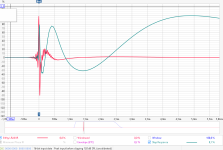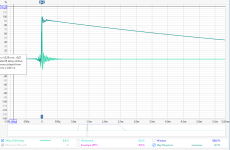Background: I've successfully built a passive small 2-way paired with a DIY under-bed subwoofer. Next project (with no particular hurry or deadline) is a pair of 3 way bookshelves inspired by Troels' Bookshelf-3WC. Really just borrowing the driver alignment. Would like to make the cabinets sealed rather than ported but if I need to port to get down to ~40hz I will. Speakers will be on a literal bookshelf surrounded by books.
This will be a hybrid active/passive, active DSPed crossover for the woofer to mid/tweeter, and passive between those. Aiming to cross over between woofer and mid at <200, and to the tweeter over 7k. System will be for casual listening in a library, aiming for a wide listening area rather than a sweet spot, and will not be played loud.
So far these are the drivers I'm looking at. But this is where my expertise flags so really let me have it.
Woofer: Dayton RS225P-8A
Mid: TB WS-2143
Tweeter: Dayton ND25FA-4
The woofer I've used before in the bedroom sub and like it well enough there, and in this application isn't having to take on the midrange.
This will be a hybrid active/passive, active DSPed crossover for the woofer to mid/tweeter, and passive between those. Aiming to cross over between woofer and mid at <200, and to the tweeter over 7k. System will be for casual listening in a library, aiming for a wide listening area rather than a sweet spot, and will not be played loud.
So far these are the drivers I'm looking at. But this is where my expertise flags so really let me have it.
Woofer: Dayton RS225P-8A
Mid: TB WS-2143
Tweeter: Dayton ND25FA-4
The woofer I've used before in the bedroom sub and like it well enough there, and in this application isn't having to take on the midrange.
I think you are crossing from the full range to the tweet way to high. The mid will start beaming around 3kHz and the tweeter is capable of crossing below 3kHz. See Troels about beaming. The Dayton paper woofer is a good choice, I'm not sure about the Tangband, I never heard one.
http://www.troelsgravesen.dk/Beaming.htm
http://www.troelsgravesen.dk/Beaming.htm
I was aiming to cross the tweeter low to help get the CTC of the mid/tweeter within the quarter wavelength at the crossover.
But I get the beaming now. The TB driver didn't have any off-axis measurements and I can't find any third party ones or I'd have noticed that. Given that I may ditch the mid and look for something more traditional than a full range since it won't help me cross the tweeter lower.
Edit: I'm also trying based on some things I've read to avoid the mid/tweeter crossover in important frequency ranges where the hearing is most sensitive.
But I get the beaming now. The TB driver didn't have any off-axis measurements and I can't find any third party ones or I'd have noticed that. Given that I may ditch the mid and look for something more traditional than a full range since it won't help me cross the tweeter lower.
Edit: I'm also trying based on some things I've read to avoid the mid/tweeter crossover in important frequency ranges where the hearing is most sensitive.
As I suspect, if you divide frequencies with a phase-lined filter, you can divide at any convenient frequency.Edit: I'm also trying based on some things I've read to avoid the mid/tweeter crossover in important frequency ranges where the hearing is most sensitive.
My midrange and high frequencies are divided at 2.5 kHz, I don't hear any problems with this crossover frequency. I also know people who divide midrange and high frequencies at 2 kHz, and they don't hear any problems either. We are talking about active division using DSP.
Off to learn about phase-lined filter, though I was planning on a passive for the mid/tweet cross. All very preliminary.
You can predict the frequency where the narrowing will happen based on the cone size, even though measurements are better at showing the nuances.didn't have any off-axis measurements and I can't find any third party ones
A good cross isn't audible. It's just not easy to do.I've read to avoid the mid/tweeter crossover in important frequency ranges where the hearing is most sensitive.
A phase-linear filter allows all three drivers to work synchronously and in phase, which in turn facilitates wave summation from each driver and prevents sharp phase rotation at the crossover frequency. As a result, there is nothing in this region for the ear to latch onto.
Here is the step response of a passive three-way LR24 crossover.

And this is the step response of a three-way phase-linear LR24.

The three peaks in the first image indicate that each driver emits sound at a different moment in time, which can sometimes be perceived as a slight smearing of speech articulation or instruments. In the second image, all three drivers emit sound simultaneously, leaving nothing for the ear to latch onto. A three-way speaker system with this kind of step response is perceived as a very high-end full-range driver.
P/S/ for greater clarity, I have provided the results of measuring the sum of the three crossover outputs, rather than measuring the speaker.
Here is the step response of a passive three-way LR24 crossover.

And this is the step response of a three-way phase-linear LR24.

The three peaks in the first image indicate that each driver emits sound at a different moment in time, which can sometimes be perceived as a slight smearing of speech articulation or instruments. In the second image, all three drivers emit sound simultaneously, leaving nothing for the ear to latch onto. A three-way speaker system with this kind of step response is perceived as a very high-end full-range driver.
P/S/ for greater clarity, I have provided the results of measuring the sum of the three crossover outputs, rather than measuring the speaker.
Last edited:
You can predict the frequency where the narrowing will happen based on the cone size, even though measurements are better at showing the nuances.
A good cross isn't audible. It's just not easy to do.
I'm up for the challenge. In my first 2-way, I think I spent 20ish hours in VituixCAD trying things out. It was very satisfying to build the v2 crossover after I had tried to build one off of the various "build a crossover based on numbers but no measurement" threads. I wired the second crossover into one but not both speakers and wired them both to an A/B switch and played my favorites. My and my wife's eyes were wide about the difference. Night and day.
Video of one of them, fwiw:
Polar response unevennes (crossover lobing, driver directivity mismatch etc), non-linear distortions (HD, IMD etc) still can happens similar to non phase-linearized filtering/crossing.A phase-linear filter allows all three drivers to work synchronously and in phase, which in turn facilitates wave summation from each driver and prevents sharp phase rotation at the crossover frequency. As a result, there is nothing in this region for the ear to latch onto.
- Home
- Loudspeakers
- Multi-Way
- Tear down my three-way driver selection